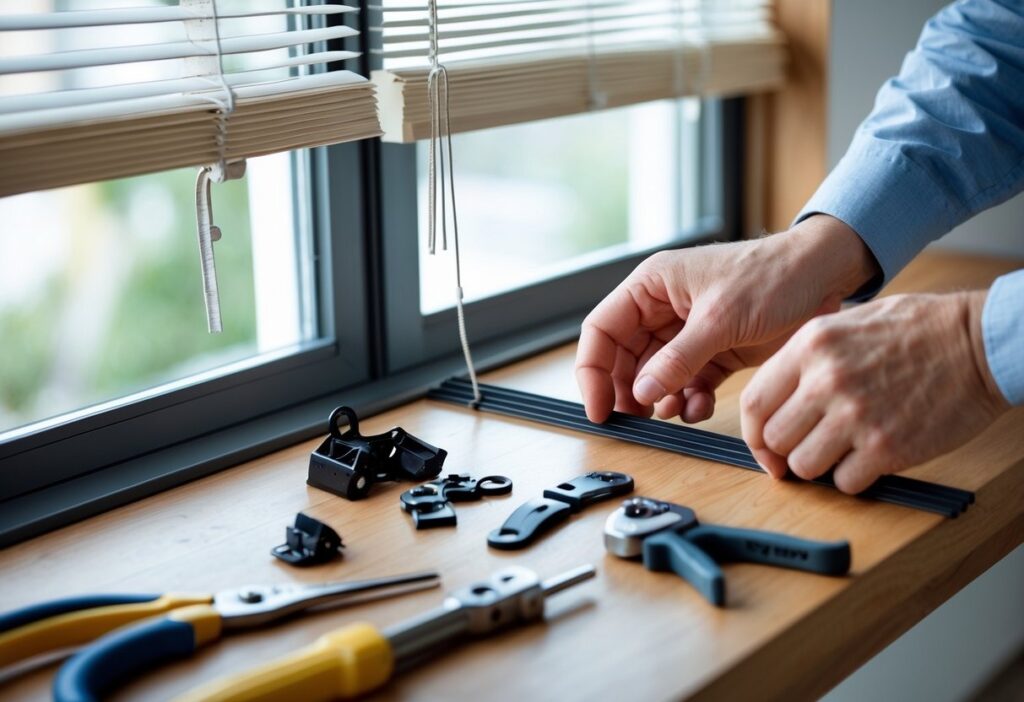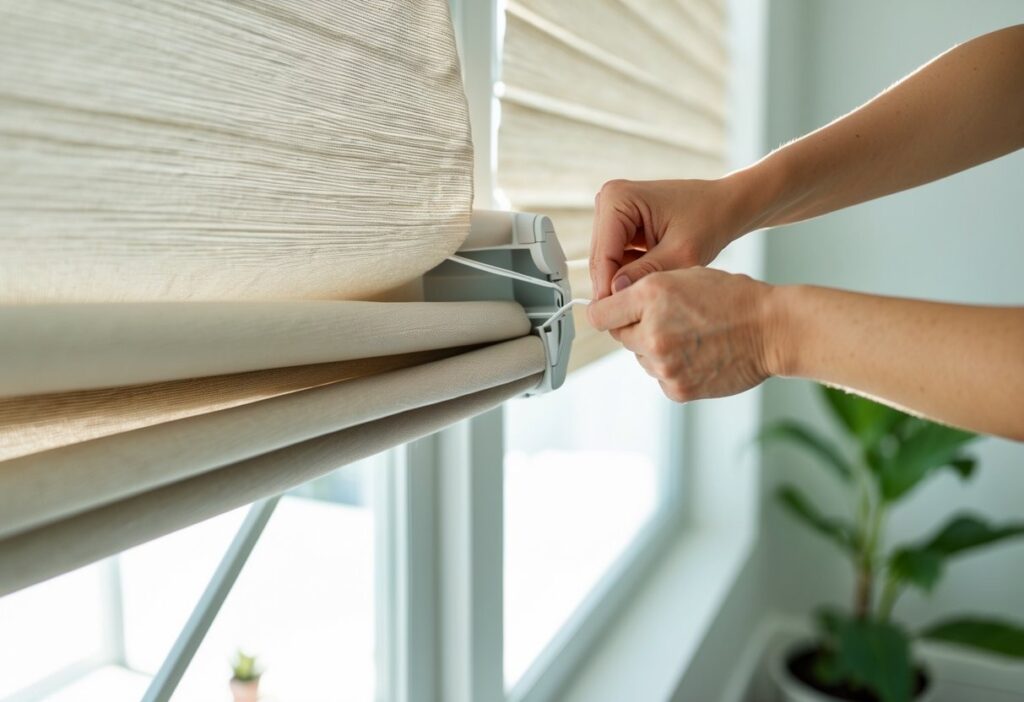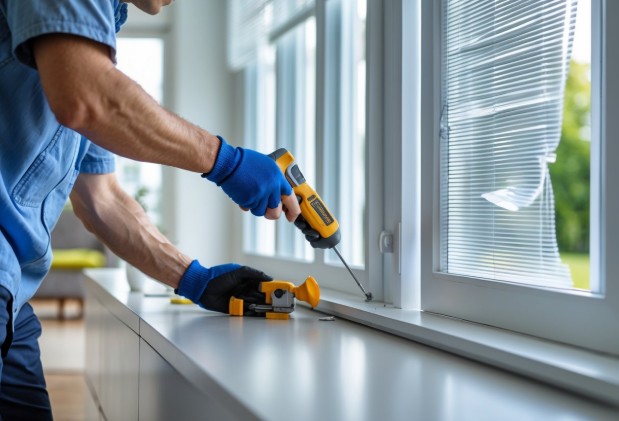When blinds snap, shades jam, or motors stop responding, you lose privacy, light control, and calm.
Most emergencies can be stabilized fast with basic tools and targeted checks—buying time until a pro finishes the job right.
You can get things working again with simple tweaks to cords, brackets, or power connections.
If you know how to spot the problem and use the right temporary fix, you can stop things from getting worse and keep your privacy intact.
It pays to keep some basic repair supplies around. If you know when to try a DIY fix and when to call a pro, you’re already ahead of the game.
Key Takeaways
- Most window treatment emergencies can be stabilized safely using simple steps before a professional repair.
- A 60-second safety check (power, cords, mounting) tells you whether DIY is safe or not.
- A small at-home repair kit—spare vanes or slats, plugs, batteries, a mini screwdriver—helps handle most quick fixes.
First, Triage The Problem Safely (60-Second Assessment)

Just as nurses perform a rapid triage assessment, homeowners need to spot window treatment damage that poses a real safety risk, rather than just an eyesore.
Some problems need professional help—fast—so you don’t get hurt or make things worse.
Red-Flag Issues That Need A Pro Now
Electrical hazards are at the top of the danger list for motorized blinds and shades. If you see exposed wires, smell something burning, or notice a sparking motor, stop right there and call a professional.
Structural mounting failures can be just as risky. Heavy window treatments that pull away from the wall or ceiling can fall and injure someone. Watch for:
- Bent or cracked mounting brackets
- Holes are getting bigger around the screws
- Sagging or tilting hardware
- Wall damage behind the mounts
Cord strangulation hazards are a big deal if you have kids or pets. Frayed cords, broken cord stops, or dangling loops all need immediate attention from a pro.
Extensive glass panel damage in sliding doors or big windows? Don’t try to handle cracked or shattered glass yourself. That’s a job for someone with the right gear.
Fast Fixes For Common Blind/Shade Failures

Vertical blinds lose vanes regularly, which messes up the whole system. Venetian blinds? Their cords break or slats get bent from everyday use.
Vertical Vane Popped Out / Misaligned Stem
Step 1: Locate the Problem. Find the vane that fell out of its carrier clip. The white carrier should still be up on the track.
Step 2: Align the Stem. Hold the vane upright and look for the small stem at the top. That stem has a little hook that slides into the carrier clip.
Step 3: Reattach the Vane
- Gently push the stem up into the carrier
- You should hear a soft click
- The hook catches inside the carrier
Step 4: Test Movement Pull the wand to rotate all the vanes. The one you fixed should move with the rest.
When Stems Break: If the stem snaps off, you’ll need to replace the whole vane. Most hardware stores sell replacement vertical blind vanes in common sizes.
Prevention Tips:
- Don’t pull on individual vanes
- Use the wand for adjustments
- Clean the carriers every month to keep them moving smoothly
Venetian Slat/Cord Hiccup
Broken Lift Cord Repair: Take the blind down and lay it flat. Cut away the busted cord, leaving some extra for tying knots.
Thread in the new cord, following the same path as before. Start at the bottom and work your way up through each slat.
Tie a good knot at the bottom rail. Make sure the cord feels snug before you hang the blind back up.
Bent Slat Solutions: If a slat’s just a little bent, lay it on something flat and gently press it straight.
If it’s really wrecked, swap it out. Blind repair guides often say you can just remove broken slats if the rest of the blind still works.
Quick Fixes:
- Tape Method: Use clear tape on small cracks
- Slat Removal: Take out damaged pieces
- Cord Adjustment: Retie loose knots at the bottom
Tools Needed:
- Scissors for cutting cord
- Tape for quick patches
- Replacement cord from the hardware store
Boca Blinds offers fast diagnostics and on-site repairs for blinds, shades, and shutters—with replacement options when fixes aren’t enough. Regain privacy and comfort quickly. Contact us today.
Uneven, Crooked, Or “Won’t Roll Up” Shades

Roller and cordless shades that hang crooked or won’t roll up often just need a bracket tweak or a spring reset. Most of the time, it’s misaligned brackets or a spring that’s lost its oomph.
Quick Re-Level Method For Rollers/Cordless (Under 10 Minutes)
Step 1: Check the brackets. Take the shade down and look at both mounting points. Are the screws loose? Did a bracket shift?
Step 2: Realign the brackets. Grab a level and make sure both brackets are at the same height. If one’s lower, loosen it and move it up to match the other.
Step 3: Reset spring tension. If the shade won’t roll up, pull it all the way down and take it off the brackets. Roll it up by hand, then put it back. That usually resets the spring.
Step 4: Test the operation. Hang the shade back up and try it a few times. It should roll up smoothly and hang straight.
If it’s still crooked after all that, you might have a busted bracket that needs replacing.
Motorized Not Responding? Do The 4-Point Reset.

Most motorized blind issues come down to power problems, lost connections, or a remote that’s just not talking to the motor.
The fix is usually a step-by-step reset: batteries, wiring, remote, then the motor itself.
Batteries, Connections, And Basic Resets (Somfy-Style) Before Deeper Diagnostics
Step 1: Battery Check Pop out the battery pack from the motor head. Check for corrosion, and swap in fresh batteries that match the voltage.
Test the motor right after. Sometimes, that’s all it takes.
Step 2: Connection Verification If you’ve got hardwired blinds, check the power at the junction box with a multimeter. Make sure all the wire nuts are tight and everything matches the wiring diagram.
Look at the motor’s power cable for damage or loose spots.
Step 3: Remote Reset Hold both the UP and DOWN buttons for about 7 seconds until the motor jogs. That wipes the remote’s pairing and programming.
Press the PROGRAM button on the back of the remote for 3 seconds. The motor should jog again to confirm the reset.
Step 4: Motor Recalibration. Hold UP until the blinds are at the top, then keep holding for two more seconds.
Do the same with DOWN until it’s fully down, then hold for 2 seconds. This resets the motor and saves the new limits.
When DIY Becomes Risky (And Voids Warranties)
Frayed cords, bent headrails, cracked brackets, or any electrical work are unsafe to attempt and can void warranties—call a professional quickly.
Window treatment repairs can look easy, but some fixes will void your warranty or just make a mess. Motorized systems and structural changes are hazardous for warranty violations.
Warranty Check:
Warranty check: DIY on motors, electrical components, or cutting slats/fabric can void the product coverage.
Most manufacturers require authorized service for power components, while simple tightening or battery swaps are generally safe.
High-Risk DIY Actions:
- Opening up motor housings or control boxes
- Rewiring anything electrical
- Cutting or trimming slats
- Modifying mounting brackets
If you cut slats or fabric panels, you change the product for good. That usually voids the warranty, even if something unrelated breaks later on.
DIY repairs can void warranties if you’re not trained for the tricky stuff. Pros know how to keep your warranty safe while fixing things.
Always check your warranty before doing anything. Most manufacturers require authorized service for electric parts, but they’re fine with simple fixes like swapping cords or tightening brackets.
Safe DIY Tasks:
- Dusting and cleaning
- Swapping batteries in remotes
- Adjusting tension on manual controls
Get your window treatments working again with expert troubleshooting and safe repairs. Explore repair or full replacement through Boca Blinds and restore smooth operation in minutes. Schedule your appointment now.
Quick Parts & Tools You Can Keep On Hand
A small repair kit—spare vanes, bottom plugs, cord stops, batteries, and a mini screwdriver—helps stabilize most emergencies quickly.
Keep Model/Brand Notes In Your Phone For Parts Matching (Photo The Headrail Label)
Most homeowners toss out packaging and forget the details of their window treatments. When something breaks, finding replacement parts becomes a real headache.
Take photos of these key areas:
- Headrail labels with model numbers
- Brand stickers on brackets
- Motor labels on motorized blinds
- Cord mechanisms and hardware stamps
Make a folder on your phone called “Window Treatments” and drop those photos in, labeled by room. It helps to add the purchase date and where you bought them in the photo notes as well.
Essential information to record:
- Brand name (Hunter Douglas, Levolor, Bali)
- Product line (Silhouette, Duette, Wood Blinds)
- Size measurements (width x height)
- Color codes or fabric names
- Mount type (inside or outside mount)
Having these details makes matching replacement parts so much easier. Manufacturers change designs all the time, so getting the model right is key if you want everything to fit.
Boca Emergency Fix Matrix (Problem → Quick Action → Next Step)
Window treatment emergencies can catch you off guard. The emergency response planning process gives you a way to tackle urgent repairs fast.
| Problem | 60-Second Fix | If It Works |
| Broken blind slats | Remove damaged slats; redistribute remaining | Order replacements later |
| Stuck roller shade | Fully lower; square tube; hand-roll to reset spring | Monitor tracking |
| Torn curtain fabric | Fabric tape for a temporary hem/patch | Schedule repair |
| Fallen curtain rod | Reinstall with proper anchors; verify studs or use toggle bolts | Recheck in 24–48 hrs |
| Jammed vertical blinds | Open/close to re-sync the carrier; reinsert the vane until it clicks | Light test cycles |
Immediate safety comes first. Watch out for broken pieces that could hurt kids or pets.
Quick fixes buy you a little time. Most of these emergency solutions hold up for maybe a day or two.
The first few minutes of an emergency matter most if you want to stop things from getting worse. Snap a few photos of the problem before you try any temporary repairs.
Sometimes you just need to call in a pro, especially with complicated mechanisms or pricey treatments. Some repairs really do need special tools or know-how.
Keep a small kit handy: fabric tape, safety pins, screwdrivers, and extra hardware. These basics cover most window treatment emergencies you’ll encounter.
Emergency fixes keep your window coverings working when you need them. They give you privacy and control over light while you figure out a permanent solution.
DIY Vs. Pro Repair: Cost, Time, And Risk
Cost differences between DIY and professional window treatment repairs can be deceiving. DIY repairs look cheaper at first, but hidden costs sneak up on you.
Fixing simple things like curtain hooks or blind slats usually costs less than $20 in materials. If you hire a pro, repairs often cost between $75 and $200 per window treatment.
Time investment really depends. DIY repairs take 2-4 hours, especially if you need to run to the hardware store and troubleshoot a bit.
Pros usually finish most repairs in 30-60 minutes. Of course, waiting for an appointment can add days to the whole process.
| Factor | DIY | Professional |
| Material Cost | $10-50 | $75-200 |
| Time Required | 2-4 hours | 30-60 minutes |
| Warranty | None | 30-90 days |
Risk levels go up with more complicated damage. Messing up an installation or seal can cost more than just calling a pro in the first place.
Low-risk DIY tasks include swapping out broken pull cords, reattaching loose valances, or tweaking tension springs. Most folks can handle these with a little patience.
High-risk repairs—think motorized blinds, heavy drapery rods, or anything involving the wall structure—probably need a professional. Those jobs require the right tools and experience.
Professional repairs usually come with a warranty, which DIY just doesn’t offer. That warranty can cover labor and materials for up to 90 days, sometimes more.
If you try a DIY repair and mess it up, you might void the manufacturer’s warranty on expensive window treatments. It’s worth double-checking before you start taking things apart.
DIY vs. Pro: Decision Guide
| Issue | DIY Friendly? | Tools/Parts | Risk If DIY | Recommended Next Step |
| Popped vane/slat | Yes | Spare vane/slat, bottom plugs | Low | Fix now; inspect carriers/stems |
| Minor roller re-level | Yes | Level, screwdriver | Low–Med | Re-level; monitor tracking |
| Cord fray/child device | No | — | High | Professional repair immediately |
| Motorized basic reset | Maybe | Batteries, manual | Low–Med | Try resetting; then pro if no response |
| Bent headrail/brackets | No | — | High | Pro repair; potential replacement |
Need It Fixed In Boca? What Boca Blinds Can Do Today
Boca Blinds has been servicing the area since 1976. They offer same-day repair solutions for damaged window treatments.
The company handles both emergency fixes and scheduled repairs. That’s pretty handy when you need something done fast.
What we Repair:
- Broken cords and strings
- Damaged slats
- Faulty tilt mechanisms
- Hunter Douglas window coverings
The team can repair almost any Hunter Douglas window covering. They usually fix most issues quickly and maintain professionalism. Not bad, right?
Service Areas Include:
- Boca Raton
- Delray Beach
- Boynton Beach
- Deerfield Beach
- Parkland
Customers can call 561-368-5322 for repairs. They’ll give you a free consultation to assess the damage and discuss your options.
Professional blind repair services in Boca Raton help keep your window treatments looking good and working right.
Emergency repairs get your privacy and light control back fast. The team shows up with the tools and parts they need for most fixes, right at your door.
Customer Experiences with Repairs and Replacements from Boca Blinds
“Timely, quality care and service… in the repair of our living room drapery traverse rods. Thank you for saving the day!” — Gregory Henry,
“The blinds they installed really updated my home… thank you for the expertise and professionalism.” — Gary Deambrose,
“I am in love with all my new window treatments… everyone involved was exceptional.” — Deborah,
“Very happy with the quality. The work was done on time and everyone was pleasant.” — Diane,
“Very positive from start to finish. I’m extremely happy with my blinds and the customer service.” — MaryBeth McDonald.
From emergency fixes to complete replacement, restore your home’s privacy, safety, and light control with a trusted local team. Resolve issues quickly with Boca Blinds—contact us to book.
Frequently Asked Questions
What’s the quickest way to fix a blind or shade that suddenly stops working?
Most issues can be stabilized by identifying the failure—slat, cord, bracket, or power—and then resetting the tension, reseating the hardware, or replacing the batteries for motorized units.
Can I safely reinsert a fallen vertical blind vane myself?
Yes. Rotate the blinds fully open and closed to re-sync the carrier, then push the vane stem into the clip until it clicks into place.
Why is my roller shade crooked or rolling unevenly?
Uneven brackets or lost spring tension cause crooked rolling. Level both brackets, fully lower the shade, hand-roll the tube to reset tension, then test again.
What should I do if my motorized blinds stop responding?
Start with fresh batteries, check power connections, remove obstructions, then perform a manufacturer reset. If the motor still won’t jog, schedule a professional repair.
When is it unsafe to attempt a DIY window treatment repair?
Avoid DIY when you see frayed cords, bent headrails, cracked brackets, or any electrical issues. These problems can cause injury and void the product warranty.
Should I repair or replace damaged window treatments?
Minor issues—loose vanes, simple cord fixes, or bracket alignment—can be repaired. Severe damage, broken mechanisms, or aging materials often require complete replacement for long-term reliability.
Does Boca Blinds offer on-site repair for broken blinds and shades?
Yes. Boca Blinds provides on-site repairs for blinds, shades, and shutters, plus replacement options when a full upgrade is the better solution, for many major brands.


